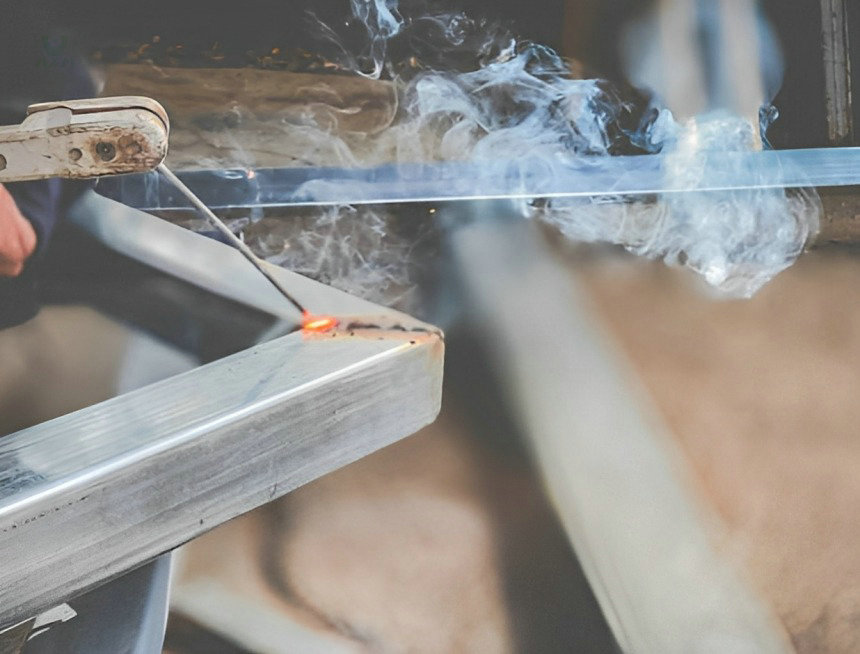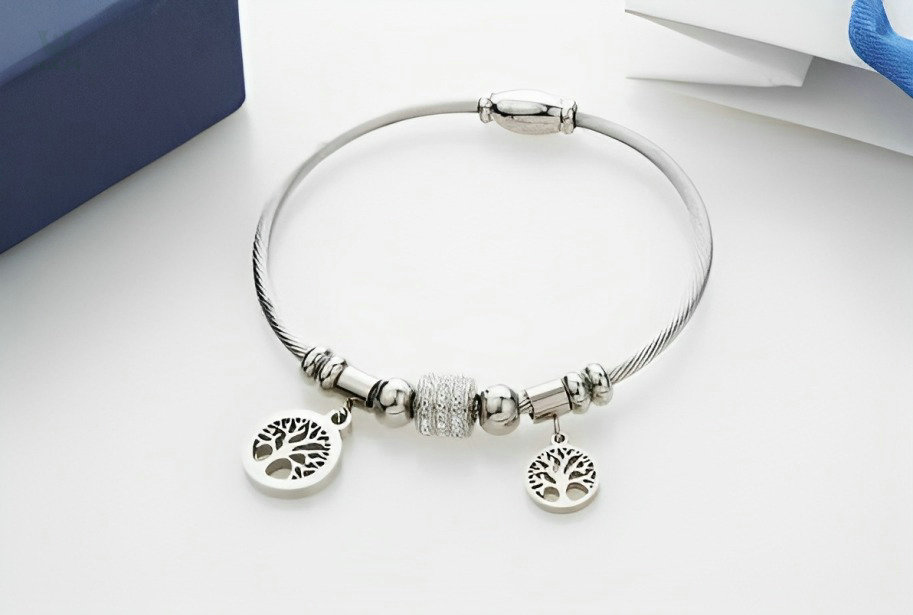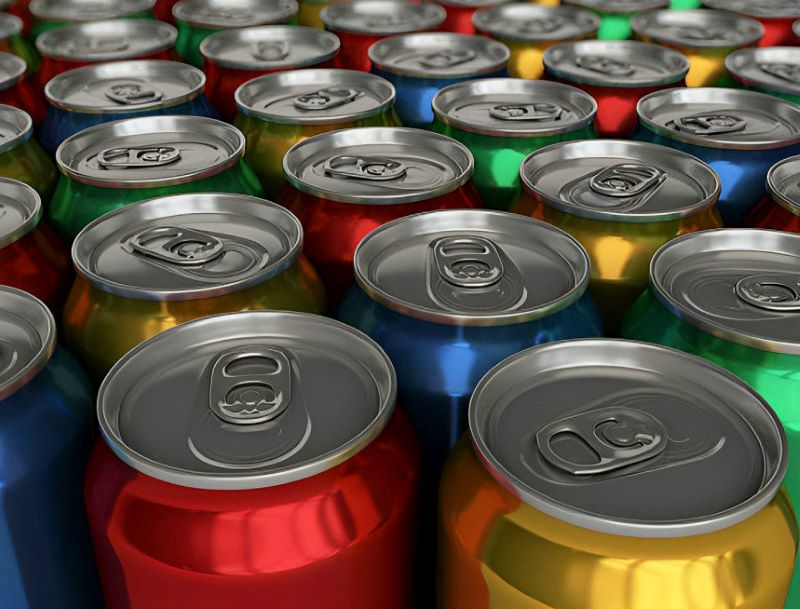Welding, the art and science of fusing metals together, has played a pivotal role in shaping our modern world. From towering skyscrapers to intricate machinery, welding has been the backbone of industrial progress. Among the myriad of metals used in welding, carbon steel stands tall as one of the most versatile and widely utilized materials. But the question remains: can you weld carbon steel? As we don our welding helmets and ignite the torch, let us embark on a journey of discovery to unravel the secrets of welding carbon steel.
can you weld carbon steel?
Yes, you can weld carbon steel. Welding is a widely used technique to join metals, and carbon steel is no exception. Carbon steel is weldable due to its low carbon content, which makes it responsive to various welding processes such as arc welding, MIG welding, and TIG welding. The key is to choose the appropriate welding method based on the thickness and type of carbon steel.
All You Need to Know About Welding Carbon Steel
In the world of metalworking, welding serves as the fundamental process that unites various components, creating sturdy and reliable structures. Among the diverse array of metals, carbon steel stands as a versatile and widely used material, finding its place in an extensive range of applications. If you’ve ever wondered about the art and science of welding carbon steel, you’ve come to the right place. Whether you’re a seasoned welder or a curious enthusiast, let’s dive in and uncover the essential knowledge you need to weld carbon steel with confidence and finesse.
What is welding?
Welding is a pivotal process in the realm of metalworking, where it plays a crucial role in joining metal components to create unified structures. This transformative technique involves melting the edges of two or more metal pieces and fusing them together, generating a robust and durable bond. As an indispensable part of modern industry and construction, welding enables the fabrication of diverse structures, from intricate machinery to towering buildings. The significance of welding lies in its ability to merge different materials and shapes, providing endless possibilities for innovation and design. With its widespread applications across various sectors, welding stands as the backbone of metalworking, empowering engineers, artisans, and manufacturers alike to craft intricate and resilient creations that shape the world we live in.
What is carbon steel?
Carbon steel, renowned for its versatility and resilience, stands tall as one of the most widely used materials in various industries and applications. Composed primarily of iron and carbon, it possesses exceptional mechanical properties that make it a preferred choice for countless engineering and manufacturing endeavors. From construction to automotive, from machinery to infrastructure, carbon steel’s adaptability knows no bounds. Its diverse grades cater to specific requirements, offering a spectrum of strength, ductility, and weldability options. As a fundamental building block in modern metalworking, carbon steel’s affordability and ease of fabrication make it accessible to both small-scale artisans and large-scale manufacturers.
Welding Carbon Steel: The Science Behind It
As sparks fly and molten metal fuses, welding carbon steel unveils the intricate dance of metallurgical transformation. Behind this seemingly magical process lies a profound science that governs the art of joining metal components. Carbon steel, with its iron-carbon alloy composition, offers a canvas of possibilities for skilled welders to create robust and reliable structures. Understanding the science behind this fusion is the key to mastering the craft and ensuring the integrity of the final product.
welding process
Welding is a remarkable process that involves joining two or more metal pieces by melting their edges and fusing them together. At the heart of this transformative technique lie three fundamental principles: heat, filler material, and metallurgical transformation.
- Firstly, heat plays a pivotal role in welding. A high-intensity heat source, such as an electric arc, laser, or flame, is used to raise the temperature of the metals to their melting point. This localized heat softens the metals, allowing them to fuse seamlessly when brought into contact.
- Secondly, a filler material is often introduced to ensure a strong bond. This additional metal, in the form of a wire or rod, melts alongside the base metals and fills any gaps between them. It acts as a bridge, reinforcing the joint and enhancing its strength.
- Lastly, metallurgical transformation takes place during welding. As the metals cool and solidify, their atomic structure rearranges, forming a new joint with unique properties. This solidified area, known as the weld bead, exhibits mechanical strength comparable to that of the parent metals.
Together, these principles govern the welding process, enabling skilled welders to create intricate and robust structures. The art of welding combines precision, expertise, and the science of metallurgy, as welders harness the power of heat and materials to forge enduring connections that shape the world around us.
carbon steel composition and weldability
Carbon steel is a versatile and widely used metal, cherished for its strength and affordability. Its composition primarily consists of iron and carbon, with small amounts of other elements like manganese, silicon, and sulfur. The percentage of carbon content determines the steel’s properties, ranging from low to high carbon steel.
In welding, carbon steel’s weldability is a crucial consideration. Generally, low carbon steels are more weldable due to their lower carbon content, which reduces the risk of cracking during the welding process. However, higher carbon steels may require preheating or post-weld heat treatment to prevent brittleness.
The weldability of carbon steel is influenced by various factors, including the carbon content, welding method, and filler material used. Skilled welders must strike a delicate balance between heat input and cooling rate to ensure a sound weld without compromising the steel’s integrity.
Carbon steel manufacturers understand the importance of weldability and produce a wide range of carbon steel grades tailored for various welding applications. From structural projects to automotive components, carbon steel’s weldability makes it a preferred choice for many industries.
In summary, carbon steel’s composition and weldability go hand in hand, empowering welders to join this versatile metal into intricate and durable structures. By comprehending the interplay of carbon content and welding techniques, carbon steel manufacturers harness the potential of carbon steel, shaping it into essential components that underpin our modern world.
significance of carbon content in welding
In the realm of welding, the carbon content of a metal plays a pivotal role in determining its weldability and overall performance. Carbon steel, a widely used metal in various industries, exhibits a spectrum of properties based on its carbon content. The carbon content influences the steel’s hardness, strength, and weldability.
Low carbon steel, with a carbon content below 0.25%, boasts exceptional weldability due to its reduced risk of cracking during welding. Welders can seamlessly join low carbon steel components, making it an ideal choice for structural applications and everyday objects.
On the other end, high carbon steel, with a carbon content exceeding 0.60%, presents challenges in welding due to its increased brittleness. Welding high carbon steel demands precise control over heat input to prevent potential cracks and failure in the weld.
Intermediate carbon steels offer a balance between strength and weldability, making them suitable for a wide range of applications, from automotive parts to machinery components.
Carbon steel manufacturers must grasp the nuances of carbon content and its impact on welding techniques to achieve sound and durable welds. Understanding the significance of carbon content empowers welders to select the right steel grade, apply appropriate pre-weld and post-weld treatments, and ultimately create robust and reliable structures.
By recognizing the relationship between carbon content and welding outcomes, carbon steel manufacturers elevate their craftsmanship, and industries benefit from the versatility and strength of carbon steel.
Techniques for Welding Carbon Steel
Welding carbon steel involves a repertoire of techniques tailored to the specific characteristics of this versatile metal. From simple joints to complex structures, carbon steel manufacturers employ various methods to ensure strong and durable connections. Understanding these techniques and choosing the most suitable approach for each application is essential for achieving successful welds.
Arc Welding (SMAW) - Shielded Metal Arc Welding
Shielded Metal Arc Welding (SMAW), commonly known as arc welding or stick welding, is one of the oldest and most widely used welding techniques for joining carbon steel. In this process, an electric arc is created between a coated electrode (stick) and the workpiece, generating intense heat that melts the base metal and the electrode. The coating on the electrode, known as flux, not only stabilizes the arc but also releases shielding gases that protect the molten weld pool from atmospheric contaminants.
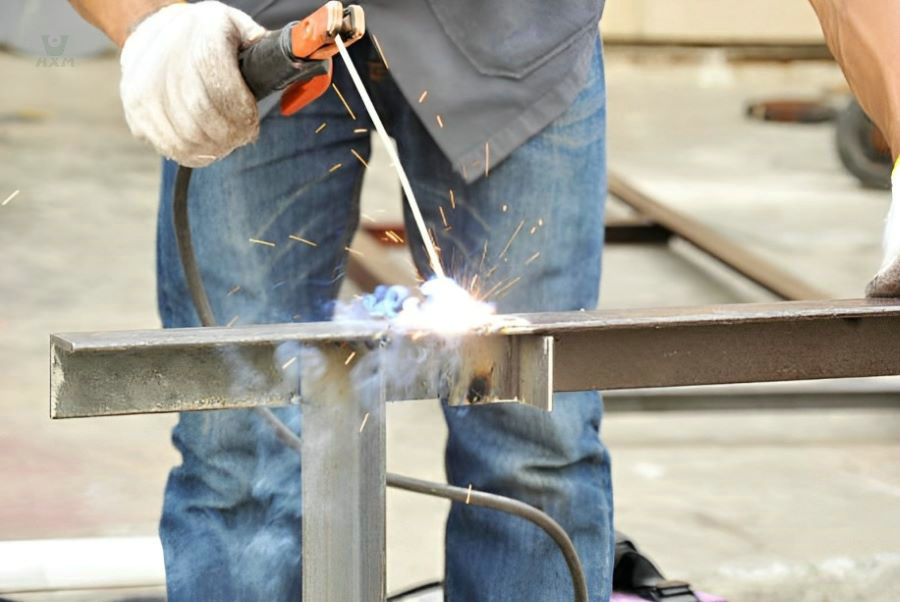
Arc welding’s versatility lies in its ability to be performed both indoors and outdoors, making it suitable for various applications and environments. This technique is especially popular in industries ranging from construction and infrastructure to fabrication and repairs.
Welders find SMAW particularly advantageous for its simplicity and cost-effectiveness. It requires minimal equipment, making it accessible for various skill levels and applications. Additionally, its adaptability to a wide range of carbon steel thicknesses and positions makes it a preferred choice in diverse welding scenarios.
However, mastering SMAW demands skill and experience. Precise control of the arc, travel speed, and electrode angle is essential for achieving high-quality welds. Carbon steel manufacturers often provide specialized electrodes tailored to the specific composition of carbon steel, further enhancing the welding process and the resulting weld strength.
MIG Welding (GMAW) - Gas Metal Arc Welding
Gas Metal Arc Welding (GMAW), commonly known as MIG (Metal Inert Gas) welding, is a popular and widely used welding technique for joining carbon steel. In this process, a continuous solid wire electrode is fed through a welding gun, and an electric arc is created between the electrode and the workpiece. Simultaneously, a shielding gas, typically a mixture of argon and carbon dioxide, is introduced to protect the molten weld pool from atmospheric contamination.
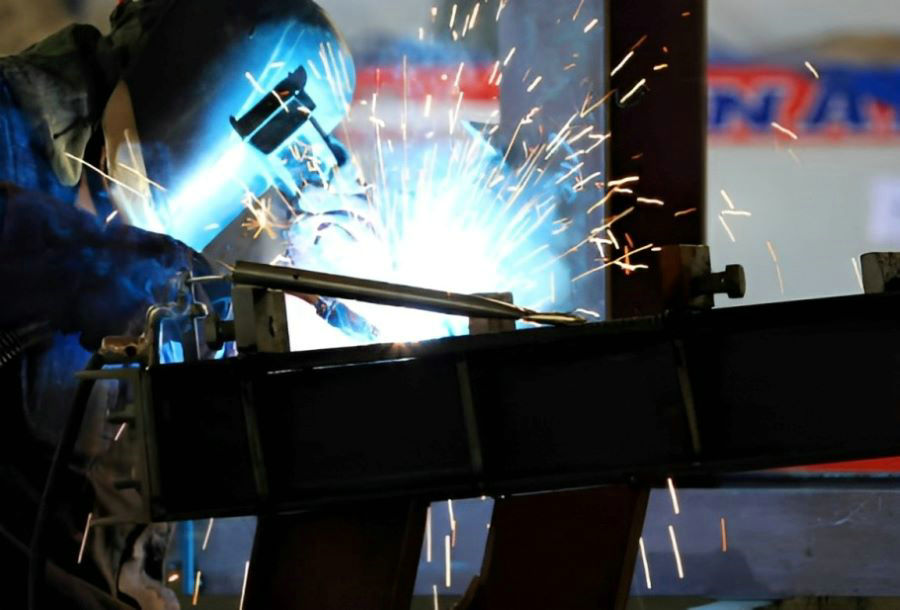
MIG welding offers several advantages, making it a preferred choice for various applications. It allows for high welding speeds and produces clean and precise welds, making it suitable for both thick and thin carbon steel materials. The continuous wire feed also reduces the need for frequent electrode changes, increasing efficiency and productivity.
Carbon steel manufacturers often provide specific welding wires designed for different grades of carbon steel, ensuring optimal weld strength and performance. Additionally, MIG welding is versatile, as it can be used in all welding positions and on a wide range of thicknesses.
This welding technique is widely used in industries such as automotive, construction, manufacturing, and fabrication. It is favored for its ease of use, which makes it accessible to welders of varying skill levels. With the right training and equipment, welders can achieve high-quality and structurally sound welds on carbon steel components.
However, successful MIG welding does require attention to detail. Proper electrode angle, wire feed speed, and shielding gas flow rate must be maintained to avoid issues such as porosity or incomplete fusion. With proper setup and technique, MIG welding remains an efficient and reliable method for joining carbon steel, meeting the demands of various industrial applications with precision and strength.
TIG Welding (GTAW) - Gas Tungsten Arc Welding
Gas Tungsten Arc Welding (GTAW), commonly known as TIG (Tungsten Inert Gas) welding, is a versatile and precise welding process used for joining carbon steel and other metals. In TIG welding, a non-consumable tungsten electrode produces an electric arc, and an inert gas, typically argon, is used as a shielding gas to protect the weld area from atmospheric contamination.
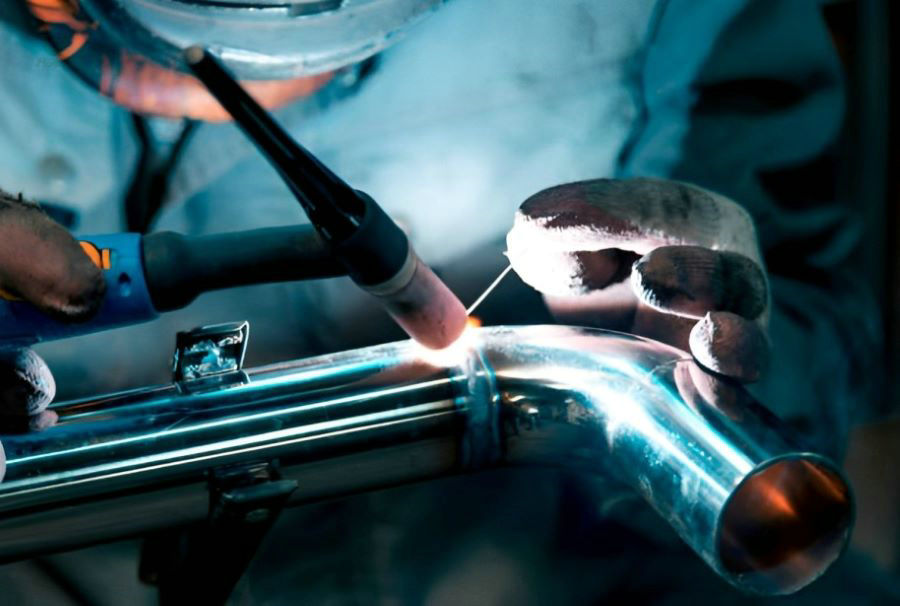
TIG welding is known for its ability to produce high-quality, clean welds with excellent control over the heat input. This makes it ideal for welding thin carbon steel sheets and precise components where aesthetics and strength are crucial. The process allows welders to create intricate welds with minimal distortion, making it suitable for applications requiring intricate details or critical weld joints.
One of the key advantages of TIG welding is the absence of filler material, allowing for “autogenous” welds, where no additional metal is added to the joint. This feature is particularly useful for applications requiring minimal material build-up or situations where heat-affected zones need to be minimized.
Carbon steel manufacturers provide various grades of tungsten electrodes optimized for welding carbon steel, ensuring the welds’ quality and integrity. GTAW can be used for both manual and automated welding processes, providing flexibility in different fabrication settings.
However, TIG welding requires a higher level of skill and precision compared to other welding techniques, making it more suitable for experienced welders. It also tends to be slower than other methods, making it less cost-effective for large-scale projects.
Despite its challenges, TIG welding’s precision and ability to produce high-quality welds have made it a popular choice in industries like aerospace, automotive, and high-end fabrication. When executed with skill and expertise, TIG welding delivers strong and aesthetically pleasing carbon steel welds that meet the stringent requirements of various applications.
Submerged Arc Welding (SAW)
Submerged Arc Welding (SAW) is a highly productive and efficient welding process used for joining carbon steel and other metals. In SAW, an arc is generated between a continuously fed bare electrode (flux-coated) and the workpiece. The weld area is shielded by a layer of granular flux, which covers the molten weld pool and prevents atmospheric contamination.

SAW is commonly employed in heavy-duty applications, such as welding thick carbon steel plates or structures, as it can produce deep and high-quality welds with minimal operator skill. The process is ideal for large-scale projects, as it allows for high deposition rates, resulting in faster welding speeds and increased productivity.
One of the notable advantages of SAW is the ability to weld thick materials in a single pass, reducing the need for multiple weld layers and minimizing distortion. Additionally, the flux acts as a thermal insulator, allowing the weld pool to cool more slowly, which contributes to improved mechanical properties and reduced risk of cracking.
Due to its effectiveness in welding thick carbon steel components, SAW is widely used in industries such as shipbuilding, construction, and heavy machinery manufacturing. Carbon steel manufacturers provide specialized fluxes tailored for welding specific grades of carbon steel, ensuring optimal weld quality and mechanical properties.
However, SAW requires proper ventilation and fume extraction due to the large amount of smoke and fumes generated during the process. The flux used in SAW can also add to the overall welding cost, making it more suitable for projects where the high productivity justifies the additional expense.
In summary, Submerged Arc Welding offers excellent efficiency and productivity when welding carbon steel, making it a favored choice for heavy and thick metal components. Its ability to produce high-quality welds in a single pass makes it a reliable and cost-effective option for a wide range of industrial applications.
Comparison of welding methods
When it comes to welding carbon steel, various methods offer different advantages and suitability for specific applications. Let’s compare some common welding techniques:
Arc Welding (SMAW)
- Suitable for all positions and thicknesses of carbon steel.
- Ideal for outdoor and remote applications due to its portability.
- Versatile and widely used, but requires skilled operators for high-quality welds.
MIG Welding (GMAW)
- Well-suited for thin to medium thickness carbon steel.
- Offers high welding speed and ease of use, making it popular in fabrication and automotive industries.
- Provides good control over the weld pool and can be semi-automated for increased productivity.
TIG Welding (GTAW)
- Excellent for thin carbon steel and critical applications.
- Delivers high-quality, precision welds with minimal spatter and distortion.
- Requires higher skill levels and longer welding times but offers superior aesthetics.
Submerged Arc Welding (SAW)
- Most suitable for thick carbon steel plates and large-scale projects.
- Provides high deposition rates, making it efficient for heavy-duty applications.
- Offers deep weld penetration and minimal operator skill requirements.
The choice of welding method for carbon steel depends on factors such as the material thickness, joint design, welding position, project scale, and available equipment. Skilled operators and proper welding parameters are essential for achieving high-quality welds regardless of the chosen method.
Carbon steel manufacturers often recommend specific welding techniques and consumables optimized for their carbon steel grades to ensure the best results and mechanical properties in welded structures. Proper weld preparation, cleanliness, and adherence to welding standards are crucial for achieving strong and reliable carbon steel welds across different applications.
Considerations and Challenges in Welding Carbon Steel
Welding carbon steel presents its own set of considerations and challenges that demand careful attention to ensure successful and robust welds. Let’s explore some essential factors:
Controlling Heat Input and Avoiding Distortion
Managing heat input during welding is critical to prevent distortion, especially in thin carbon steel components.
Proper weld sequencing and intermittent welding can help distribute heat and minimize distortion.
Carbon steel manufacturers may provide guidelines on optimal heat control for specific grades.
Preheating and Post-Welding Treatments
Preheating the base metal can reduce cracking and improve weld quality, especially for thicker carbon steel sections.
Post-weld heat treatments can relieve residual stresses and enhance weld toughness.
Following recommended preheating and treatment procedures from carbon steel manufacturers is essential.
Addressing Potential Issues with Carbon Content and Weld Quality
High carbon content in certain carbon steel grades can lead to increased hardness and susceptibility to cracking.
Proper filler material selection and preheat levels help mitigate these issues.
Understanding the carbon steel’s composition and working within specified limits ensure weld quality.
Other challenges may include handling carbon steel’s sensitivity to impurities, such as sulfur and phosphorus, which can affect weldability. Adequate welding techniques and skilled operators play a crucial role in overcoming these challenges and maintaining weld integrity.
By collaborating with carbon steel manufacturers and following industry best practices, welders can successfully navigate the complexities of welding carbon steel. Ensuring the right welding procedures, equipment, and personnel are in place enhances the performance and reliability of carbon steel welds for various applications.
conclusion
In conclusion, the answer to the question “Can you weld carbon steel?” is a resounding yes. Carbon steel’s weldability and versatility make it a popular choice in various industries and applications.
Working with carbon steel requires knowledge of its composition, carbon content, and heat sensitivity. Collaborating with carbon steel manufacturers can provide valuable insights and guidelines for successful welding practices.
As we’ve explored the different welding techniques and considerations for carbon steel, it becomes evident that mastering this craft opens up countless possibilities for creative and innovative solutions. Whether in manufacturing, construction, or automotive sectors, carbon steel’s weldability empowers welders to bring their ideas to life.
In the world of welding, carbon steel offers a canvas for exploration and creativity. Embracing the knowledge gained from this journey enables us to produce robust and enduring structures, components, and designs. Let us continue to advance our welding skills with carbon steel, unlocking its potential to shape a better and more resilient future.

